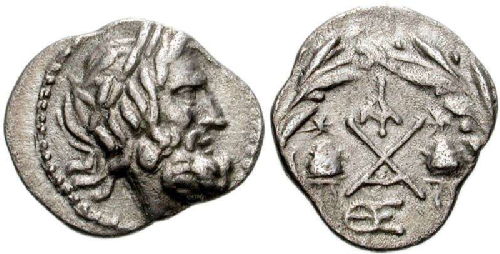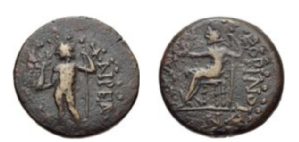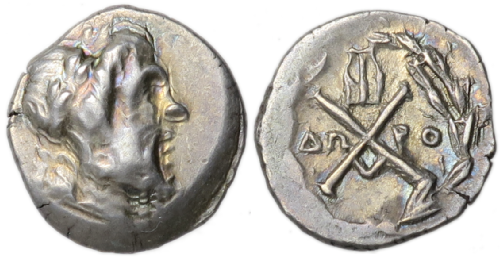All 1 entries tagged Achaean
No other Warwick Blogs use the tag Achaean on entries | View entries tagged Achaean at Technorati | There are no images tagged Achaean on this blog
September 01, 2019
Achaean League Coinage and Collective Identity
On the Greek mainland in the Hellenistic Period, some of the city states united into federal leagues, the most successful of these being the Achaean League. In my undergraduate dissertation I wanted to show how the Achaean League developed its collective identity and how this affected the policy and the society of the League. Collective identity is how states and individuals can identify with both their home city and the overarching political body (i.e. a modern example is me saying I am both European and British). The coinage of the Achaean League acted as a means of spreading this message throughout the League. In this blogpost, I’m going to show how the coinage reflected the policy of collective identity. To examine this topic in depth I’m going to examine a coin from Megara and how the Megarians reconciled the ‘Dorian’ and ‘Achaean’ aspects of their identity.
Types of Achaean Coinage
 |
Achaean Hemidrachm, minted at Sparta, with symbol of Dioscuri caps and abbreviation of LA on the reverse, and head of Zeus Homarius on the obverse.
Polybius proudly states that the Achaeans “formed the states into a community of allies and friends, but they have also adopted the same laws, weights and measures and coinage…” (Polybius, Histories, 2.37). This has been interpreted as a way of showing “the social and political solidarity of the second-century Peloponnese.” (Thonemann (2015) 72). These coins were silver hemidrachms, worth half a drachm, and were minted in nineteen different poleis of the Achaean League. Each of these cities produced the coins to a similar blueprint: a head of Zeus Homarius on the obverse, and a monogram of the word Achaean on the reverse. The different mints are indicated with either abbreviations or with symbols, such as the Pegasus of Corinth.
 |
Achaean tetrachalkon, minted at Corinth, Obverse: Zeus with sceptre and holding Nike in his hand. Reverse: Seated figure of the personified Achaea. Both motifs were common throughout the Hellenistic World.
These ethnics and symbols helped to bind the cities to the league by associating them with the federal Achaean body and making them as one and the same, whilst celebrating the individual characters of the cities themselves; it shows dedication to the federal ideal. This is further proved by the bronze coinage of the league, which was struck in over forty-five out of the seventy odd cities in the league. These small poleis were committed to the league and were willing to invest heavily in that relationship. Warren suggests that over 1600 dies were used in the minting of these bronze coins, which is an extremely heavy investment, especially compared to how other poleis minted coins in the Hellenistic Period (Warren (2007); Thonemann (2015) 74).
Maintaining local identity in a federal state
 |
Achaean Hemidrachm, minted at Megara. Obverse: Head of Zeus Homarius. Reverse: Achaean League monogram and abbreviation of word Dorian.
The collective identity of the Achaean League didn’t mean that various local identities were weakened. In fact, the network of poleis meant that they strengthened their local identities, and the environment of competition between the constituent members changed. Coinage was one media that expressed this.
This coin from Megara helps to show the nuance that went into how the ancient Greeks identified themselves. Across the Achaean monogram is the abbreviated ethnic, but rather than denoting the city of Megara, it draws attention to the Greek ethnic group of the Dorians. The Egyptologist Lynn Meskell has said that “identity is what is draped over a person by the groups of which he or she is part” ((1999) 32), indicating that identity is multi-faceted and complex, consisting of many layers. The complicated layers of this coin show that the people of Megara want to advertise their history as Dorians, and the political reality of their position as members of the Achaean League. One did not trump the other, and from the view of inter-polis competition, the historical baggage of the term will have had an effect on how Megara was received within the league.
Conclusion
This examination of Achaean coinage has shown how integrated the society of the Achaeans was, and that whilst Polybius’ assertion that the Peloponnese was a “single state” (2.37) is apt, the situation was a lot more complicated. Each member state had its own agenda and history, but worked under the umbrella of Achaean identity in order to be stronger and more efficient (Close (2018)). The coinage of the various states of the Peloponnese show how these states were able to reconcile the identities that both united them and showcased their uniqueness.
Bibliography
Primary
Polybius, Histories, trans. Waterfield, R. Oxford University Press: Oxford 2010.
Secondary
Close, E. “Megalopolis and the Achaean Koinon: Local Identity and the Federal State.” Teiresias 48.1 2018: 2–8.
Meskell, L. 1999. Archaeologies of Social Life. Oxford: Blackwell Publishing Ltd.
Thonemann, P. 2015. The Hellenistic World: Using Coins as Sources. Cambridge University Press: Cambridge.
Warren, J. 2007. The Bronze Coinage of the Achaion Koinon: the Currency of a Federal Ideal. London: Royal Numismatic Society.
 |
This month’s entry was written by Jameson Minto, who recently graduated from Warwick. His dissertation was titled ‘The Achaean League and Collective Identity’ and dealt with the evolution of both the institutions of the league and the creation of the Achaean identity. Jameson runs his own blog, Musings of Clio, which discusses the ancient world, and he is set to study an MA in Classics and Ancient History at the University of Manchester.
 Clare Rowan
Clare Rowan

 Please wait - comments are loading
Please wait - comments are loading

 Loading…
Loading…

